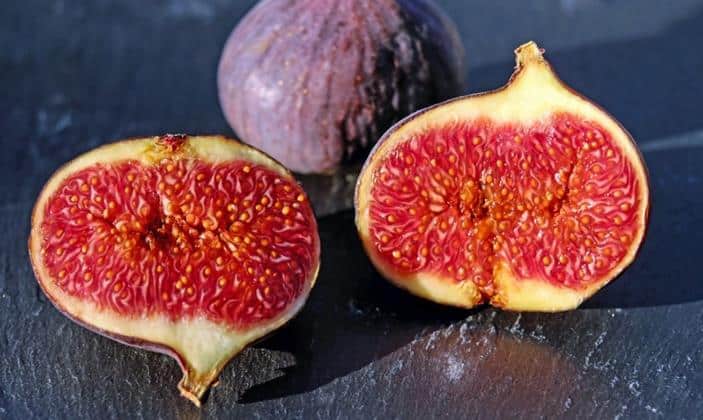Figs are praised for their health benefits. Should you let your dogs eat figs, and are their plant (leaves, stems, or bark) safe to dogs or harmful?
Fig refers to the plant or fruits of over 850 species of Ficus in the family Moraceae, commonly known as the mulberry family. Some common species are Ficus carica (common fig) and Ficus benjamina Indian Rubber Plant or weeping fig.

They are ideal shade plants, house plants (ornamental plants, thanks to their rubbery, glossy leaves), valued for their healthy fruits (especially Ficus carica), some species have a religious significance, and so on.
Can dogs have figs?
Yes. Dogs can have ripe fig fruits as an occasional treat. Keep the amount to about a ¼ to ½ a fruit or less twice to three times a week. If you didn’t know, figs are high in sugars, with a medium 40-gram fruit having 6.5g of sugar and about 30 calories.
Feeding too many of these fruits to your dogs may cause obesity since they are high in calories. Also, avoid dried figs since they are even higher in sugars and calories. For instance, sugar accounts for per 100g figs with 30% water is about 54g.
Although they are high in sugars, they still make a great treat in very tiny amounts. Some of their benefits include
1. Nutritious with natural sugars
Dogs can eat fruits, digest, and utilize the various nutrients they have like natural sugars and thiamine, riboflavin, pantothenic acid, vitamins B6 and K, calcium, manganese, potassium, magnesium as well as some phytochemicals.
2. Dietary fiber source
Dogs need dietary fiber. Both soluble and insoluble and these fruits are an excellent source of fiber that will boost a healthy digestive system, help in diarrhea or constipation, weight loss, and so on.
Also, fiber helps improve satiety, something that may promote weight loss. However, these fruits are also high in carbohydrates, mostly dried ones.
3. Potassium-rich
They are rich in potassium, good for healthy heart and muscle function, enzymes and nerves, and fluid balance to regulate blood pressure. While little is detrimental and may result from vomiting, diarrhea, irritable bowel disease, or malnutrition, too much is also harmful.
4. other benefits
There are promising studies in rats that extract from F. carica fruit may help bring down blood pressure while its leaf extract will help keep optimal total cholesterol. (1 2, 3).
Feeding figs to dogs
Besides the small amount, ensure you introduce fruits gradually, starting with a very tiny amount as you observe any abnormal signs such as drooling, vomiting, or drooling.
Also, go for organically grown ones as they don’t have pesticides or herbicides that may be harmful to your canine pal.
No to fig plant leaves or stem
Dogs shouldn’t eat fig leaves, bark, stems, or unripe fruits because their milky sap (latex sap) has ficin and psoralen, showing low to moderate toxicity. While the leaves and bark have the highest concentration, raw fruit skin and rind have some declines as they ripen(4).
There have been reports of Ficus benjamina, causing poisoning in dogs in Europe, especially Italy (5, 6, 7). If you think it is only this species, the ASPCA notes that Ficus spp. are toxic to dogs, cats, and horses since all Ficus species the milky latex.
Toxicity symptoms
Contact with fig sap will cause dermal irritation on the skin, while ingestion will result in gastrointestinal distress. It will also cause eye irritation, and some of the common symptoms include:
- Drooling or watery eyes
- Vomiting
- Diarrhea
- Face pawing or rubbing
- Skin irritation, blistering,
- Oral pain and sores in their mouth or tongue
If you suspect your dog has eaten fig plant or has any of the above symptoms, talk to your vet for further diagnosis and treatment.
Are Fig Newtons bad or good?
As you enjoy your fig Newton, your dog may want a bite. Is it ok or to give them a taste or not? Are they safe for toxic to these pets?

No. fig newtons, which are Nabisco-trademarked pastry rolled figs made by extrusion, are not toxic to dogs. However, they are not healthy, either. Looking at their ingredients, you will notice they have whole wheat grain flour, invert sugar (glucose and fructose), corn syrup, sugar, salt, baking soda, canola oil, palm oil, among others.
It is unsuitable because it is very high in calories and sugars, with a 28g pack (with two cookies) having 100 calories and about 12g of sugar (42%). The high sugar isn’t suitable for diabetic dogs, as it may cause a blood glucose spike.
Feeding your pet just a single biscuit means you have consumed a whopping 50 calories, something that will exceed the maximum calorie requirement from treats that shouldn’t exceed 10% of total calorie intake.
These cookies also have sulfur dioxide (preservative) and common allergens like milk, wheat, soy, and gluten, making it not suitable for dogs with allergies to any of these ingredients.
However, if your dog ate a tiny piece of fig Newton biscuit, it is unlikely to harm your dog. However, too much may cause obesity and weight gain. Therefore, we don’t recommend them.
